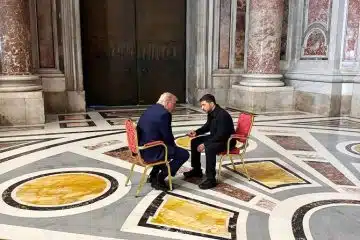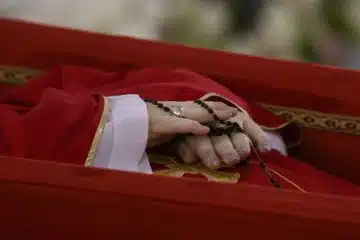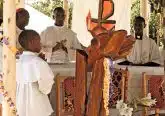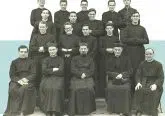Speakers, exhibit highlight plight of Congo
Thursday, June 4, 2009
By Carmen M. Hubbard
ST. FRANCIS DE SALES DEANERY — The Sisters of Charity of Cincinnati and the Comboni Missionaries recently co-sponsored a photo exhibit featuring people of the Congo to help break the silence of atrocities that continue in the war-torn country.
The exhibit, called “Shattering the Silence: Democratic Republic of the Congo,” opened at the Sisters of Charity Motherhouse in Delhi Township on May 17, where it remained for one week. During its second week, from May 31 to June 5, the exhibit was featured at the Comboni Mission Center in Anderson Township.
 |
| Lumana Pashi, an adjunct professor at the University of Cincinnati, discusses the Congo at the Comboni Mission Center. (CT/Carmen M. Hubbard) |
Guest speaker Lumana Pashi, vice president of development of the Crossroads Center and an adjunct professor at the University of Cincinnati, discussed the country’s plight, noting that nearly 6 million people have been killed in the past 10 years.
“What’s happening in the Congo takes courage to expose. The exhibit is just the tip of the iceberg,” he said to an audience on May 31.
Pashi is and a native of the Congo Catholic, what was formerly Zaire. He has lived in the United States for 26 years. He and his wife, Marie, and their family live in West Chester Township.
According to Pashi, the Congo is the size of the United States east of the Mississippi River. Its population is approximately 65 million people and it has more than 250 ethnic groups. The Congo has the second largest forest in the world after the Amazon. The country has various minerals such as uranium, gold and copper that have been the source of violence among ethnic groups from neighboring countries in Africa. These groups have killed the Congolese to gain control of their land that is rich with minerals.
“An important aspect to understand is numerous minerals are still being discovered,” Pashi said. “People of the Congo are being killed for doing nothing. In the process, women and girls are raped. About one-third of them are HIV positive. The military cannot protect the huge country and territory. Any country can take advantage of the Congo.”
Pashi noted that Congolese minerals, or “blood minerals” as he called them, are used to manufacture technological devices such as cell phones and electronic games.
Comboni priests and Catholic Relief Services provided the photos for the exhibit that showed young children rummaging through garbage searching for food and teenage boys with semi-automatic rifles draped across their bodies as members of a militia.
“Crimes against humanity need to be shattered. Take what you hear and share that,” Comboni Father Paul Ciuciulla said as he introduced Pashi.
Comboni Missionaries have served in the Congo for several decades. Currently, there are 130 missionaries in the Congo.
At the Sisters of Charity motherhouse, the photo exhibit featured guest speaker Luvungu “Felicity” Muyumba, who is Congolese. She spoke on May 17.
“Life is still bad,” she said to the audience. “The country has already been destroyed. They are living in a very tough situation. When you see Africans in Kroger or Western Union, they’re sending money home. Even though Congo looks poor, it is a very, very rich country. All the diamonds (in the United States) came from there.”
Muyumba is the wife of John K. Kalubi, who is from Zambia and is the field service assistant professor of African and African Diaspora literatures at the University of Cincinnati. The couple and their children are members of St. Monica-St. George Parish Newman Center in Cincinnati.
Vince Costello is the director of international services for the American Red Cross, Cincinnati Area Chapter. He spoke at both exhibit openings and emphasized the Red Cross’ humanitarian efforts in the Congo. Boys are forced to serve in militias in the Congo or risk being murdered, Costello said. Often times, they’re made to kill their relatives.
“I’ve seen how gang lords have taken children from their families and turned them into killing machines,” Costello said. “When we try to bring them back, their families won’t accept them because the kids have killed relatives on the orders of their gang lords. People like the Comboni Missionaries try to do what they can in the Congo.”
Initially, the Sisters of Charity had planned an exhibit on Darfur. Because the western region of Sudan has received so much media attention, the Sisters of Charity chose the Congo instead. They hoped the exhibit would inform and educate others about the atrocities that have happened.
“The war in the Congo is underreported,” Sister of Charity Louise Akers said. “Almost 6 million people have been killed. What’s shocking is statistics of women who have been tortured, raped, their bodies mutilated, and (then they) are ostracized because of it.”
Pictures of Jesus Christ when He was crucified were featured throughout the exhibit. It was a reminder, Sister Louise said, for observers to recognize the face of Christ in the faces of the Congolese.
Organizers said a U.S. Senate bill is in the works that will expose what’s happening in the Congo, if it’s passed. In the meantime, Pashi encouraged people to contact their senators and insist something be done to stop the violence in the Congo.
Cindy Browne is the manager of the justice and peace office of the Comboni Missionaries. She said it was the first time the missionaries and the Sisters of Charity have worked together to help raise awareness about Africa.
“We’re still interested in Darfur. When we looked into (the photo exhibit of the Congo), we knew it was the right thing to do,” Browne said.













